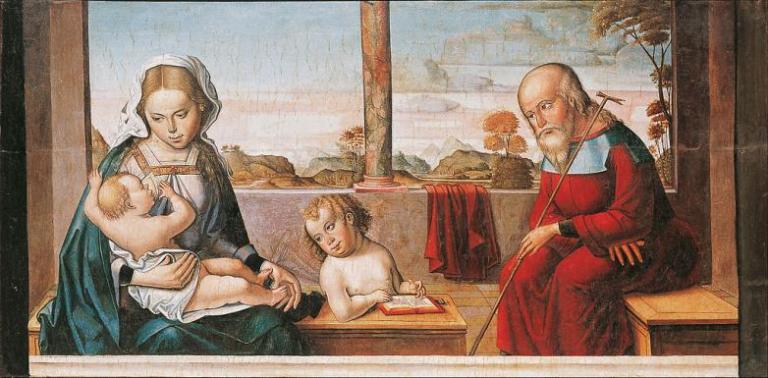In the controversy over Judge Roy Moore’s pursuit and alleged assault of adolescent girls, one of his defenders made a scurrilous comparison with the Holy Family. He said that Joseph was an old man, while Mary was a teenager. Thus there cannot be anything wrong with a much-older man being attracted to young girls. But as religion journalist Tom Verde shows, the portrayal of St. Joseph as an old man is not from the Bible but was put forward by those arguing for Mary’s perpetual virginity.
In his article Sorry, Roy Moore. Joseph Wasn’t Twice Mary’s Age in POLITICO Magazine, Verde cites scholars who say that for Jews of the first century the groom would typically be in his 20’s with the bride in her teens. So the age difference would not be that great.
The Bible is silent about their ages. It is true that Joseph is not mentioned after his 12-year-old son is misplaced in the Temple (Luke 2:41-52). The New Testament mentions other members of Jesus’s family after He takes up His ministry. Presumably, Joseph died before that time. This does not mean, however, that Joseph had been an old man when he married Mary. (It would, however, mean that among the human travails that the Son of God experienced in His incarnation was the death of a parent. We should keep this in mind when we go through that universal, but mournful experience. Jesus knows what that is like.)
Verde says that the portrayal of Joseph as an old man started when the role of Mary increased in the 4th Century. All agreed, in the words of the Apostle’s Creed, that Jesus was “conceived by the Holy Spirit” and “born of the Virgin Mary.” But many Christians insisted that Mary remained a virgin all her life.
But the Gospels refer to the brothers and sisters of Jesus:
“Is not this the carpenter, the son of Mary and brother of James and Joses and Judas and Simon? And are not his sisters here with us?” (Mark 6:3)
55 Is not this the carpenter’s son? Is not his mother called Mary? And are not his brothers James and Joseph and Simon and Judas? 56 And are not all his sisters with us? Where then did this man get all these things?” (Matthew 13:55-56)
One way to reconcile these texts with the notion of Mary’s perpetual virginity is to believe that these brothers and sisters were from an earlier marriage by Joseph. According to this view, Joseph married a second time to Mary when he was a widower getting on in years. After Jesus was born, Joseph was too old to be interested in the sexual part of marriage. This view became popular in the Church and was reflected in some of the art and drama of the Middle Ages.
There are, however, other possibilities, even if one accepts the perpetual virginity of Mary. The term “brothers and sisters,” some say, could be used for other close kindred. Mary may well have taken in a deceased sister’s children and raised them in her household, and they might have been called “brothers and sisters.” Or the individuals quoted in the Gospels, who are critics of Jesus, just didn’t understand who these relatives were and jumped to the conclusion that they were Jesus’s siblings.
Most Protestants have no problem with the thought that Mary and Joseph had a normal marriage after Jesus was born. Indeed, that would seem to be the implication of the “until” language in the first chapter of Matthew:
When Joseph woke from sleep, he did as the angel of the Lord commanded him: he took his wife, but knew her not until she had given birth to a son. And he called his name Jesus. (Matthew 1:24-25)
If she and Joseph did have other children, the vocation of marriage is such that this would by no means lessen her purity.
By the way, the Latin version of the Smalcald Articles (I.4) in the Book of Concord calls Mary “semper virgo”; that is, “always virgin” or “ever virgin.” Many confessional Lutherans believe they are obliged on this basis to affirm Mary’s perpetual virginity. Others say that this is just a “pious opinion” without scriptural basis and that the phrase in the confession does not appear in the German version and so is not binding. For that discussion see this and this.
To be sure, Joseph might have been older and might have had other children from a second marriage, or these other explanations might hold true.
But, as Verde points out, in any event, the “old Joseph” model does not depict an old man with sexual desire for a teenager. The whole point of the “old Joseph” is to establish the non-sexual nature of the couple’s relationship.
Illustration, “Holy Family with Young St. John,” by Master of Astorga Active in Castile, first half of 16th century Details of artist on Google Art Project [Public domain], via Wikimedia Commons














